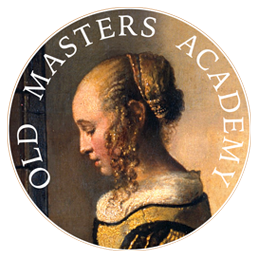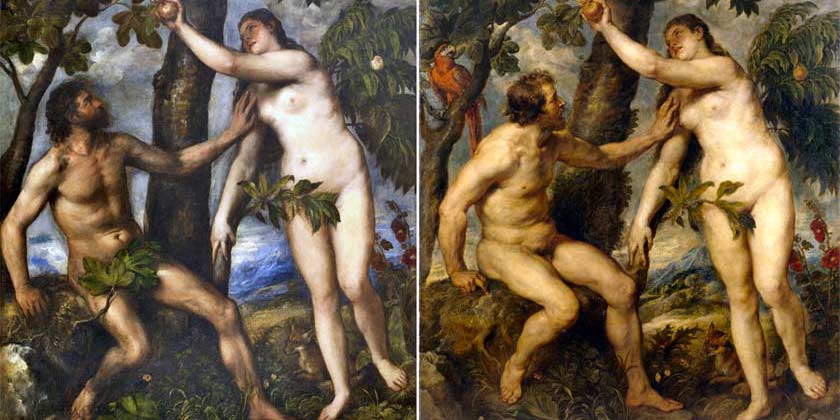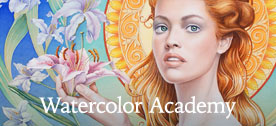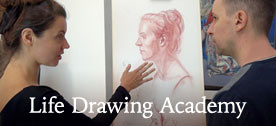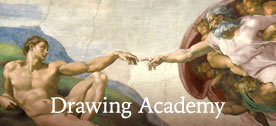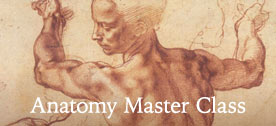by Rosily Roberts
Rubens’s copies of old masters
After completing his apprenticeship and being admitted to the Antwerp guild for painters in around 1600, Peter Paul Rubens travelled to Italy, with the aim of learning from the great Italian Renaissance masters in Venice and Rome. While there, he was exposed to the work of such artists as Titian, Tintoretto, Raphael and Michelangelo, and the art he saw was undoubtedly formative to his career and his development of an artistic style. Later, in the 1620s, when he was working as a diplomat, he was summoned to Madrid to inform Philip IV of Spain of diplomatic negotiations then taking place between Spain and England. The trip turned into a nine-month stay.
Not only did he view these works, but he also made numerous copies of Italian old masters, many of which survive to this day.
During his stay in Spain, Rubens made copies of many of the more than fifty paintings by Titian then in the Spanish Royal Collections. One such work is copy of Titian’s Rape of Europa, now in Madrid’s Prado Museum, which he completed in 1628-29. It is a faithful copy of Titian’s own 1562 painting of the same name. It depicts the well-known classical story from Ovid’s Metamorphoses of Europa, who was abducted by Zeus in the form of a white bull after he fell in love with her. The painting shows the princess, barely holding on to one of the bull´s horns as she is taken to Crete, where she bore his child, Minos. The story is highly charged with erotic potential, as is demonstrated by Europa’s exposed breast, and has been recreated by many artists since classical antiquity.
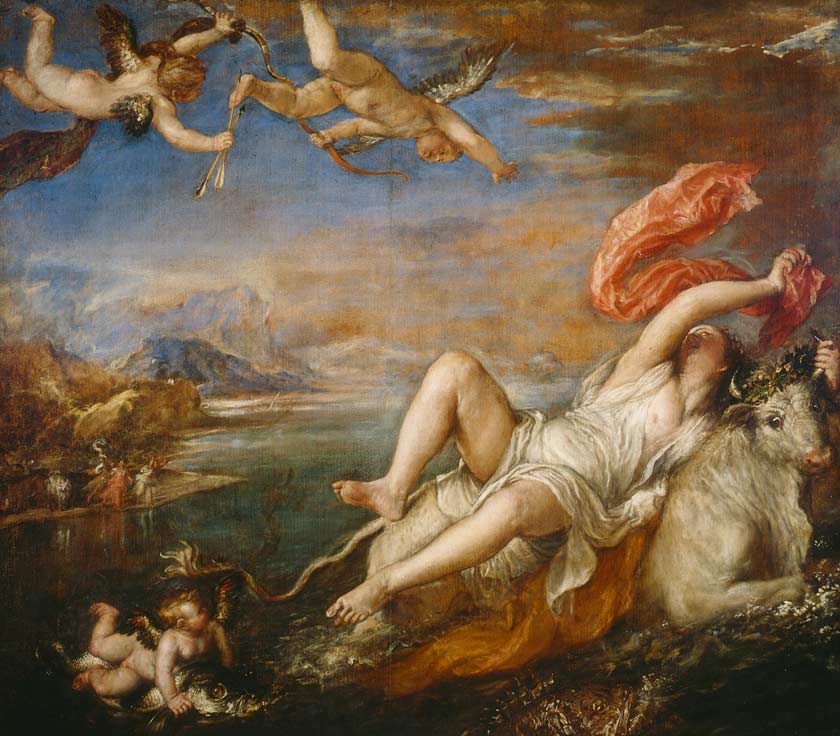
Rubens became interested in Titian’s work for several reasons, including his own recent abandonment of carefully drawn and modelled forms. He had begun to work in a more sensual, sensuous style, with unblended brushstrokes and rich colours, as well as a more erotic portrayal of his subjects. Subsequently, Titian provided Rubens with a wealth of inspiration. Titian’s Rape of Europa is an erotically charged work consisting of soft, blurred lines and the use of bright but gentle colours. Rubens has brought all of these characteristics into his own version, mimicking, among other things, Titian’s off-centred composition, and the sense of dynamism and drama that underscores the whole work.
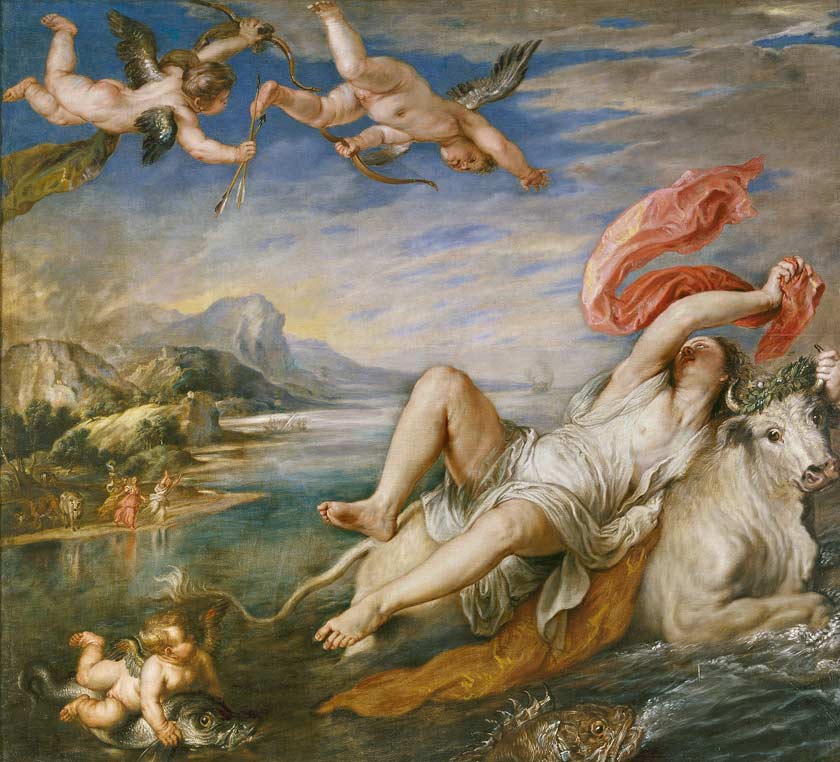
However, Rubens departed from Titian’s work in the rendering of the female body. Rubens used cool grey half-tints and emphasised the suppleness of Europa’s flesh, demonstrating his own approach to form and colour. Rubens was also working to the taste of the Spanish King’s tastes, copying the mythological scenes charges with erotic content in his collection. In the 1630s, Philip IV commissioned similar works by Rubens for his palaces, and, upon the artist’s death, Philip purchased many of his works that depicted mythological nudes, such as The Three Graces and The Garden of Love. It was then that he acquired the Rape of Europa, among with other copies of Titian’s work by Rubens.
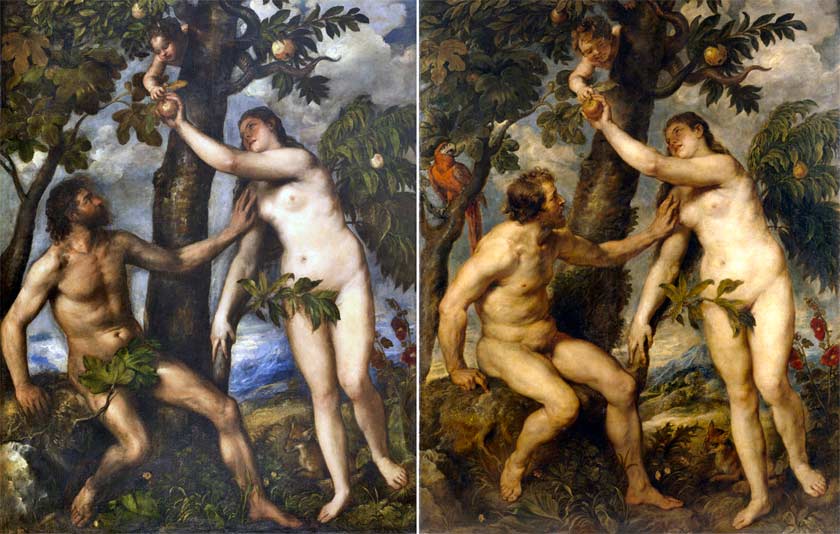
Rubens used a similar treatment in his copy of Titian’s Adam and Eve, which was made during his same trip to Spain. In Titian’s work, Eve is shown accepting the apple from the devil, who is half child and half serpent, while Adam feebly tries to stop her.
In keeping with his own concept of painting, he made significant changes to the original, including a more intense palette. He altered Adam’s posture and made him more muscular, in accordance with his interest in depicting the body as curvaceous.
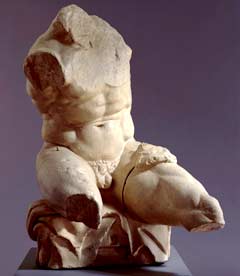
In fact, Rubens’ Adam was based on the sculpture of the Belvedere Torso in the Vatican Museum, another nod to classicism. Eve too is portrayed as fleshier and less smooth than Titian’s own original woman. Rubens has further heightened the drama of the scene by making Adam’s facial expression seem more shocked and alarmed by Eve’s actions.
Rubens also included a parrot not present in Titian’s work as a symbol of Good and strengthening the idea of redemption, in contrast to the fox that symbolises evil and lust. Rubens’ placement of the symbols is worth noting; the parrot sits behind Adam, aligning him with good and redemption, while the fox rests behind Eve’s foot. Rubens’ landscape is more naturalistic than Titian’s, giving the scene a firmer foundation in present day Northern Europe, however, what is consistent with the original is his use of thick, swirling, expressive lines and bold colours in the background.
The techniques and styles that Rubens learnt from copying old masters are visible in his works from throughout his life, most notably in the drama and dynamism of his classical works, as well as in his clear preference for colour over line, and the looseness of his forms.
References:
The Rape of Europe, Rubens (after Titian), Museo del Prado,
museodelprado.es/en/the-collection/art-work/the-rape-of-europe/a136a9c4-3a2f-44bd-ab8a-97fd47c30d7
Adam and Eve, Rubens (after Titian), Museo del Prado,
museodelprado.es/en/the-collection/art-work/adam-and-eve/de0047db-6f8b-4761-a55b-ad41e959cca2
The Rape of Europa, Titian, Isabella Stewart Gardner Museum, gardnermuseum.org/experience/collection/10978
Learn time-honored oil painting techniques of the Old Masters!
What you will get:
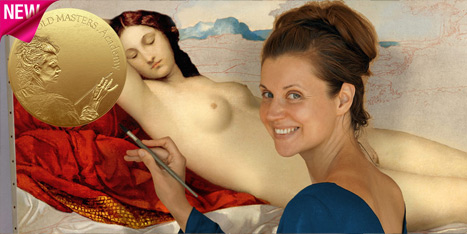
- Instant access to all 60 multi-part video lessons
- A lifetime membership
- Personal coaching by the course tutor
- Constructive critiques of your artworks
- Full access to the Art Community
- Exhibition space in the Students Gallery
- Members-only newsletters and bonuses
- Old Masters Academy™ Diploma of Excellence
How you will benefit:
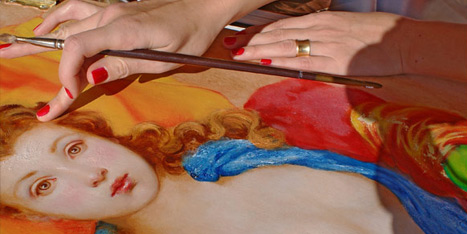
The Old Masters Academy™ course is very comprehensive, yet totally beginner friendly. All you need to do is watch video lessons one by one and use what you’ve learned in your creative projects. You will discover painting techniques of the Old Masters. This is the best art learning experience you can have without leaving your home. All information is delivered online, including personal support by the course tutor.
